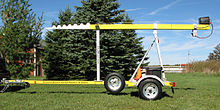Pole Aerial Photography
The Pole Aerial Photography (German about "rod aerial photography") is a special kind of aerial photography . The photographer is on the floor, the camera is mounted on a pole, usually a telescopic mast. In this way, heights of up to around 20 meters can be reached.
Compared to other types of aerial photography
- Pole Aerial Photography covers a height range of only up to about 20 meters for the camera position, the height perspective and the size of the subject, which can be surveyed without distortion, are accordingly limited. Pole aerial photography is not dependent on the weather .
- With a - manned - airplane or helicopter , however, a minimum altitude of typically 150 m should be maintained. The greater height allows the imaging of larger areas and objects, but makes the method more sensitive to haze . Vibration of small powered aircraft almost absolutely requires the manual holding of a camera. Gliding areas with limited access and possible flight times, a motor glider offers advantages.
- Drones (UAVs, multicopters) can be flown higher than 20 m and are sometimes subject to wind.
- A ladder as the simplest variant is often sufficient to raise the point of view to depict a smaller group of people standing on the level or a larger group standing on a grandstand.
Kite Aerial Photography
- In kite aerial photography , a certain amount of wind is needed to keep the kite level. Wind is more detrimental to pole aerial photography, as it creates a torque on a (unsupported) mast, which leads to more difficult control of the camera.
technology
The mast
An extendable telescopic mast is usually used as the mast, as one-piece masts are difficult to transport. The mast can be permanently mounted on a car or as a portable version with a heavy tripod on the ground.
The swivel head
A servo-controlled tripod head is required so that the camera can be operated remotely from the ground. Such heads are already available to buy, but many photographers use their own designs. With SLR cameras, it was previously not possible to check the viewfinder image from the ground. Therefore, some tripod heads also have a cheaper, small video camera that allows at least a rough estimate of the viewfinder image.
Cameras
As a rule, remote controllable digital cameras are used in pole aerial photography.
Point-and-shoot cameras
These small digital cameras have offered the advantage of remote control via a computer for a number of years. The viewfinder image can be transmitted live from the camera to the computer and all settings (zoom, focus, release) can be made from there.
Digital SLR cameras
Only in the latest generation can digital SLR cameras also be remote controlled. However, you have to compromise on the zoom here. For film cameras and the older generations of digital single-lens reflex cameras, only one additional video camera could be used to assess the viewfinder image and the autofocus. Remote triggering alone is also possible with these models.


